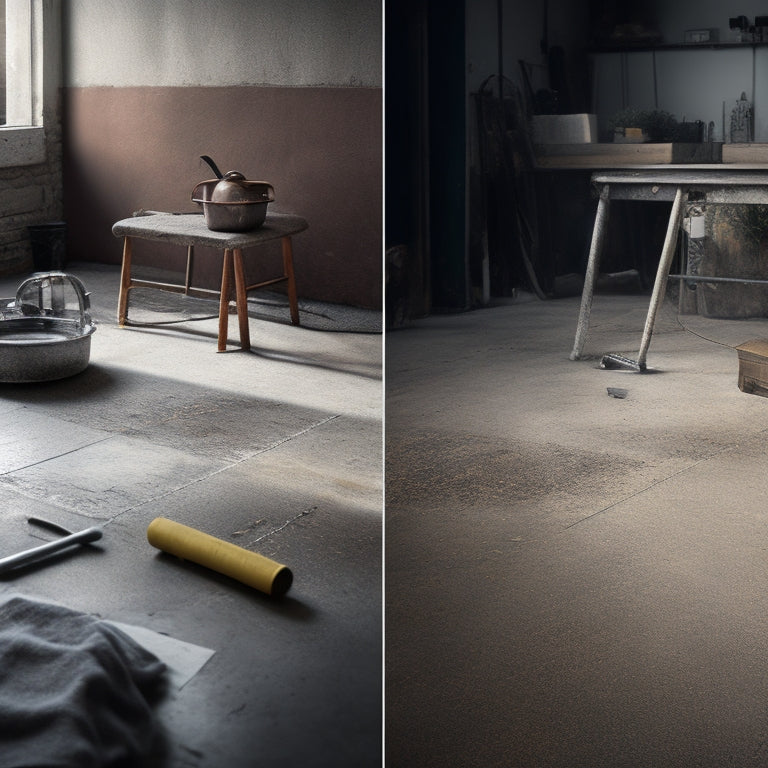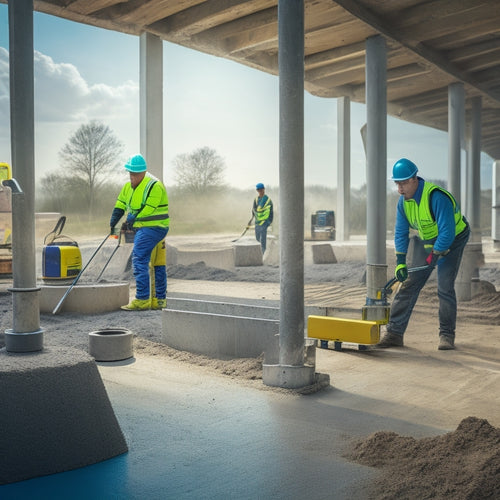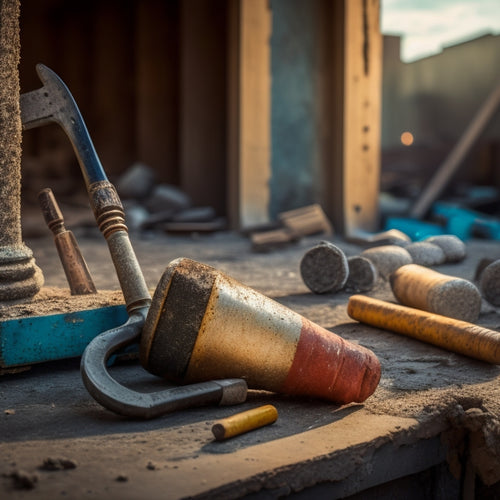
5 Best Tools for Sealing Stamped Concrete Successfully
Share
When sealing stamped concrete, you'll need a range of specialized tools to achieve a professional-looking finish. Start with the right brushes, such as natural bristle for large areas, synthetic for details, and foam for tight spaces. Then, select the ideal applicator tool, like foam or microfiber, based on your sealer type. Rollers, including microfiber, lambswool, and foam, help create smooth finishes, while edging tools provide precision control. Finally, consider using sprayers for efficient coverage, choosing from high-pressure, handheld, or backpack models. With these essential tools, you'll be well on your way to a flawless, long-lasting seal - and understanding the nuances of each tool will take your results to the next level.
Key Takeaways
• Natural bristle brushes are ideal for large area sealer application, while synthetic brushes are better for detailed work and edge cutting.
• Specialized tools like foam applicators and microfiber applicators provide precise control over the application process for achieving perfection.
• Microfiber rollers, lambswool rollers, and foam rollers are essential for smooth finishes, with nap length and density affecting the final result.
• High-quality edgers with adjustable handles and precision-crafted tips ensure precise control where sealer meets other surfaces.
• Sprayers, including high-pressure, handheld, and backpack sprayers, are necessary for efficient coverage, with effective coverage techniques like sectioning the area with a grid pattern.
Essential Brushes for Stamped Concrete
When sealing stamped concrete, you'll need a range of high-quality brushes to guarantee a smooth, even application and to reach every crevice and texture.
You'll require different brush types, each designed for specific tasks. Natural bristle brushes are ideal for applying sealer to large areas, while synthetic brushes are better suited for detailed work and cutting in around edges. Foam brushes are perfect for getting into tight spaces and corners.
To achieve peak performance, it's essential to maintain your brushes properly. Regularly clean your brushes with soap and water to prevent sealer buildup.
Allow them to air dry, and store them in a dry place to prevent damage. Inspect your brushes regularly for signs of wear, and replace them as needed.
Sealing Applicator Tools for Perfection
You'll need to complement your brush collection with specialized sealing applicator tools to achieve a flawless finish and guarantee sealer penetration into the concrete's texture and crevices.
These tools are designed to provide precise control over the application process, allowing you to adapt to different sealant types and concrete textures.
For instance, foam applicators are ideal for applying solvent-based sealers, while microfiber applicators are better suited for water-based sealers.
When choosing an applicator tool, consider the specific applicator techniques required for your project. Some tools are designed for flooding, while others are better suited for detail work.
By selecting the right tool for the job, you can guarantee a consistent, even application that enhances the beauty of your stamped concrete.
Remember, the right applicator tool can make all the difference in achieving a professional-looking finish.
With the right tools in your arsenal, you'll be able to tackle even the most complex sealing projects with confidence.
Rollers for Smooth Finishes Guaranteed
By selecting the right roller for your sealing project, you can achieve a smooth, even finish that showcases the unique texture and pattern of your stamped concrete. The key is to choose a roller that's designed for your specific sealing needs.
There are several roller types to evaluate, including microfiber, lambswool, and foam rollers. Microfiber rollers are ideal for water-based sealers, while lambswool rollers are better suited for solvent-based sealers. Foam rollers, on the other hand, are great for applying thin, even coats of sealer.
When it comes to finish techniques, you'll want to assess the nap length and density of the roller. A shorter nap length is best for smooth finishes, while a longer nap length is better for textured surfaces. You'll also want to experiment with different rolling patterns, such as circular or back-and-forth motions, to achieve the desired finish.
Edging Tools for Precise Control
To guarantee a professional-looking finish, you're going to need to pair your roller with the right edging tools that provide precise control over the sealer's application, particularly in areas where the stamped concrete meets other surfaces, such as walls, curbs, or sidewalks.
These areas require edging techniques that allow for precision control, ensuring a clean, sharp line where the sealer meets the adjacent surface.
For this, you'll need edging tools specifically designed for sealing stamped concrete. A high-quality edger will feature adjustable handles, allowing you to customize the angle and reach of the tool to fit your specific needs.
Look for edgers with precision-crafted tips, designed to maintain a consistent flow of sealer while minimizing drips and runs. Additionally, consider edgers with built-in shields or guides, which help contain the sealer and prevent it from getting on surrounding surfaces.
With the right edging tools, you'll be able to achieve a seamless, professional-looking finish that showcases your attention to detail and expertise.
Sprayers for Efficient Coverage
When covering large areas of stamped concrete, a high-pressure sprayer becomes an indispensable tool, allowing you to efficiently apply sealer with uniform coverage and minimal waste.
With the right sprayer, you can achieve professional-looking results without breaking a sweat. There are two primary sprayer types to take into account: handheld and backpack sprayers. Handheld sprayers are ideal for small to medium-sized areas, offering greater control and precision. Backpack sprayers, on the other hand, are designed for larger areas, providing increased capacity and reduced fatigue.
To guarantee efficient coverage, it's crucial to master effective coverage techniques. Start by dividing the area into sections, using a grid pattern to maintain even coverage.
Hold the sprayer 12-18 inches above the surface, moving in a consistent, overlapping pattern to prevent streaks and gaps. Apply the sealer in thin, even coats, allowing each coat to dry before applying the next.
Frequently Asked Questions
Can I Use a Regular Paintbrush for Sealing Stamped Concrete?
You're considering using a regular paintbrush for sealing stamped concrete, but it's not the best choice. The bristles can leave behind texture and fiber marks, compromising the seal's integrity.
Instead, opt for a high-quality, specialized brush designed for sealing, such as a lambswool or foam brush. These paintbrush types are specifically designed for efficient sealing techniques, ensuring a smooth, even application and a professional finish.
How Long Does It Take for Sealers to Fully Cure?
When you apply a sealer, you're keen to know how long it takes to fully cure.
The cure time depends on the sealer type and environmental conditions.
Acrylic sealers typically cure within 1-2 hours, while polyurethane and epoxy-based sealers can take 24-48 hours or even longer.
You'll need to follow the manufacturer's instructions and consider factors like temperature, humidity, and substrate porosity to guarantee proper curing.
What Happens if I Apply Too Much Sealer?
You're pouring on the sealer like there's no tomorrow, but be careful not to 'cry over spilled milk' – excessive application can lead to a world of trouble.
If you apply too much sealer, you'll end up with an excessive buildup that's difficult to correct. This can cause the sealer to pool on the surface, creating an uneven finish and potentially delaminating the sealer from the concrete.
Can I Seal Stamped Concrete in Direct Sunlight?
When you're about to seal stamped concrete, avoid doing it in direct sunlight, as it can cause the sealer to dry too quickly. This can lead to uneven coverage, bubbles, and a weakened bond.
Instead, choose a shaded area or seal during cooler parts of the day.
Employ advanced sealing techniques, such as applying thin coats and using a lamb's wool applicator, to guarantee a smooth, even finish that will last.
How Often Should I Reapply Sealer to Stamped Concrete?
You're wondering how often to reapply sealer to your stamped concrete, but first, let's set the stage: a well-sealed surface is just the beginning.
The frequency of reapplication depends on the type of sealer you're using and your application techniques.
If you've opted for a penetrating sealer, you might need to reapply every 2-3 years, while topical sealers may require reapplication every 1-2 years.
Stay tuned for more details on the best reapplication strategies.
Conclusion
You've got the right tools in your arsenal to seal stamped concrete like a pro.
Now, it's time to put them to work and 'cut to the chase'.
With these high-quality tools, you'll be able to achieve a flawless finish that will make your clients green with envy.
Remember, sealing stamped concrete is all about attention to detail, so don't skimp on quality.
Invest in the best tools and watch your business thrive.
Related Posts
-

Best Tools for Concrete Restoration and Repair
When tackling concrete restoration and repair projects, you need a range of reliable tools to achieve professional-gr...
-

What Tools Ensure Precise Concrete Leveling Results
You need a range of specialized tools to achieve precise concrete leveling results. Laser leveling instruments provid...
-

5 Tips for Splitting Concrete With Second-Hand Tools
When splitting concrete with second-hand tools, you'll need to be strategic to avoid wasting time, money, and putting...


